A Wideband Millimeter-Wave Dual-Beam Dielectric Resonator Antenna with Substrate Integration Capability
Abstract
:1. Introduction
2. Design of the Proposed Antenna Element
2.1. Configuration of the Proposed Antenna Element
2.2. Operating Mechanism of the Antenna Element
2.3. Parametric Study on the Antenna Element
2.4. Simulated Results of the Antenna Element
3. 1 × 4 Antenna Array and Experimental Results
3.1. Configuration of the Antenna Array
3.2. Experimental Results
4. Conclusions
Author Contributions
Funding
Data Availability Statement
Conflicts of Interest
References
- Chen, C.; Guo, Y.; Wang, H. Wideband symmetrical cross-shaped probe dual-beam microstrip patch antenna. IEEE Antennas Wirel. Propag. Lett. 2015, 14, 622–625. [Google Scholar] [CrossRef]
- Liu, P.; Zhang, Z.; Li, Y.; Feng, Z. A dual-beam eight-element antenna array with compact CPWG crossover structure. IEEE Antennas Wirel. Propag. Lett. 2017, 16, 1269–1272. [Google Scholar] [CrossRef]
- Wincza, K.; Staszek, K.; Slomian, I.; Gruszczynski, S. Scalable multibeam antenna arrays fed by dual-band modified butler matrices. IEEE Trans. Antennas Propag. 2016, 64, 1287–1297. [Google Scholar] [CrossRef]
- Kim, J.H.; Park, W.S. A hadamard matrix feed network for a dual-beam forming array antenna. IEEE Trans. Antennas Propag. 2009, 57, 283–286. [Google Scholar] [CrossRef]
- Jiang, M.; Chen, Z.N.; Zhang, Y.; Hong, W.; Xuan, X. Metamaterial-based thin planar lens antenna for spatial beamforming and multibeam massive MIMO. IEEE Trans. Antennas Propag. 2017, 65, 464–472. [Google Scholar] [CrossRef]
- Gu, L.; Yang, W.; Xue, Q.; Che, W. A dual-band steerable dual-beam metasurface antenna based on common feeding network. IEEE Trans. Antennas Propag. 2021, 69, 6340–6350. [Google Scholar] [CrossRef]
- Gu, L.; Yang, W.; Xue, Q.; Che, W. A ±45° dual-polarized dual-beam series-fed metasurface antenna array with stable beam angle. IEEE Trans. Antennas Propag. 2021, 69, 8366–8375. [Google Scholar] [CrossRef]
- Nakano, H.; Toida, M.; Okabe, S.; Yamauchi, J. Tilted beam formation using parasitic loop-based plates. IEEE Antennas Wirel. Propag. Lett. 2016, 15, 1475–1478. [Google Scholar] [CrossRef]
- Hu, C.C.; Jsu, C.F.; Wu, J.J. An aperture-coupled linear microstrip leaky-wave antenna array with two-dimensional dual-beam scanning capability. IEEE Trans. Antennas Propag. 2000, 48, 909–913. [Google Scholar] [CrossRef]
- Karmokar, D.K.; Esselle, K.P.; Bird, T.S. Wideband microstrip leaky-wave antennas with two symmetrical side beams for simultaneous dual-beam scanning. IEEE Trans. Antennas Propag. 2016, 64, 1262–1269. [Google Scholar] [CrossRef]
- Li, X.; Wang, J.; Li, Z.; Li, Y.; Geng, Y.; Chen, M.; Zhang, Z. Leaky-wave antenna array with bilateral beamforming radiation pattern and capability of flexible beam switching. IEEE Trans. Antennas Propag. 2022, 70, 1535–1540. [Google Scholar] [CrossRef]
- Dadgarpour, A.; Sorkherizi, M.S.; Denidni, T.A.; Kishk, A.A. Passive beam switching and dual-beam radiation slot antenna loaded with ENZ medium and excited through ridge gap waveguide at millimeter-waves. IEEE Trans. Antennas Propag. 2017, 65, 92–102. [Google Scholar] [CrossRef]
- Liu, S.; Qi, S.S.; Wu, W.; Fang, D.G. Single-feed dual-band single/dual-beam U-slot antenna for wireless communication application. IEEE Trans. Antennas Propag. 2015, 63, 3759–3764. [Google Scholar] [CrossRef]
- Khidre, A.; Lee, K.F.; Elsherbeni, A.Z.; Yang, F. Wide band dual-beam U-slot microstrip antenna. IEEE Trans. Antennas Propag. 2013, 61, 1415–1418. [Google Scholar] [CrossRef]
- Tan, J.; Jiang, W.; Gong, S.; Cheng, T.; Ren, J.; Zhang, K. Design of a dual-beam cavity-backed patch antenna for future fifth generation wireless networks. IET Microw. Antennas Propag. 2018, 12, 1700–1703. [Google Scholar] [CrossRef]
- Li, J.F.; Mao, C.X.; Wu, D.L.; Ye, L.H.; Zhang, G. A dual-beam wideband filtering patch antenna with absorptive band-edge radiation nulls. IEEE Trans. Antennas Propag. 2021, 69, 8926–8931. [Google Scholar] [CrossRef]
- Li, J.F.; Chen, Z.N.; Wu, D.L.; Zhang, G.; Wu, Y.J. Dual-beam filtering patch antennas for wireless communication application. IEEE Trans. Antennas Propag. 2018, 66, 3730–3734. [Google Scholar] [CrossRef]
- Katare, K.K.; Sharma, A.; Biswas, A. Dielectric resonator based pattern reconfigurable antenna. In Proceedings of the 2016 Asia-Pacific Microwave Conference (APMC), New Delhi, India, 5–9 December 2016. [Google Scholar] [CrossRef]
- Khodja, K.; Belazzoug, M.; Atia, S.; Messaoudene, I.; Denidni, T.A. Dual-beam DRA based array for 5G applications. In Proceedings of the 2021 IEEE 19th International Symposium on Antenna Technology and Applied Electromagnetics (ANTEM), Winnipeg, MB, Canada, 8–11 August 2021. [Google Scholar] [CrossRef]
- Gong, K.; Hu, X.H. Low-profile substrate integrated dielectric resonator antenna implemented with PCB process. IEEE Antennas Wirel. Propag. Lett. 2014, 13, 1023–1026. [Google Scholar] [CrossRef]
- Kremer, H.I.; Leung, K.W.; Lee, M.W.K. Design of substrate-integrated dielectric resonator antenna with dielectric vias. IEEE Trans. Antennas Propag. 2021, 69, 5205–5214. [Google Scholar] [CrossRef]
- Wu, B.; Guo, Y.; Xu, Z.; Chen, Y.; Shi, J. A wideband substrate integrated filtering dielectric resonator antenna for millimeter-wave applications. IEEE Antennas Wirel. Propag. Lett. 2024, 23, 518–522. [Google Scholar] [CrossRef]
- Tang, H.; Deng, X.; Shi, J. Wideband substrate integrated differential dual-polarized dielectric resonator antenna. IEEE Antennas Wirel. Propag. Lett. 2022, 21, 203–207. [Google Scholar] [CrossRef]
- Tang, H.; Wu, L.; Ma, D.; Li, H.; Huang, J.; Deng, X.; Zhou, J.; Shi, J. Wideband filtering omnidirectional substrate-integrated dielectric resonator antenna covering Ku band. IEEE Antennas Wirel. Propag. Lett. 2023, 22, 1746–1750. [Google Scholar] [CrossRef]
- Ge, Y.; Esselle, K.P.; Bird, T.S. Compact dielectric resonator antennas with ultrawide 60%-110% bandwidth. IEEE Trans. Antennas Propag. 2011, 59, 3445–3448. [Google Scholar] [CrossRef]
- Stutzman, W.L.; Thiele, G.A. Antenna Theory and Design; Wiley: Hoboken, NJ, USA, 2012. [Google Scholar]
- Tam, M.T.K.; Murch, R.D. Half volume dielectric resonator antenna designs. Electron. Lett. 1997, 33, 1914–1916. [Google Scholar] [CrossRef]
- Ma, C.J.; Zheng, S.Y.; Pan, Y.M.; Chen, Z. Millimeter-wave fully integrated dielectric resonator antenna and its multi-beam application. IEEE Trans. Antennas Propag. 2022, 70, 6571–6580. [Google Scholar] [CrossRef]
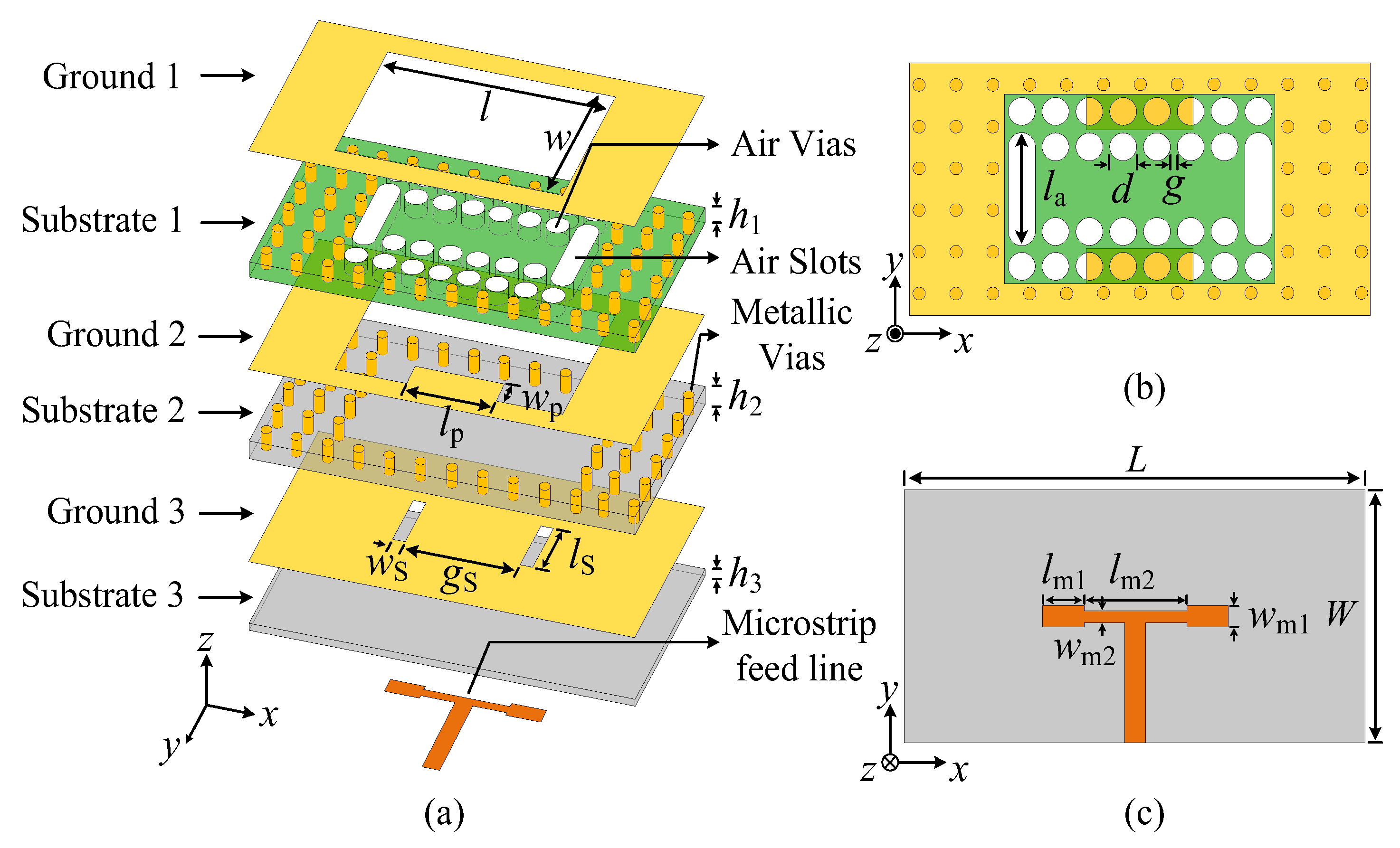

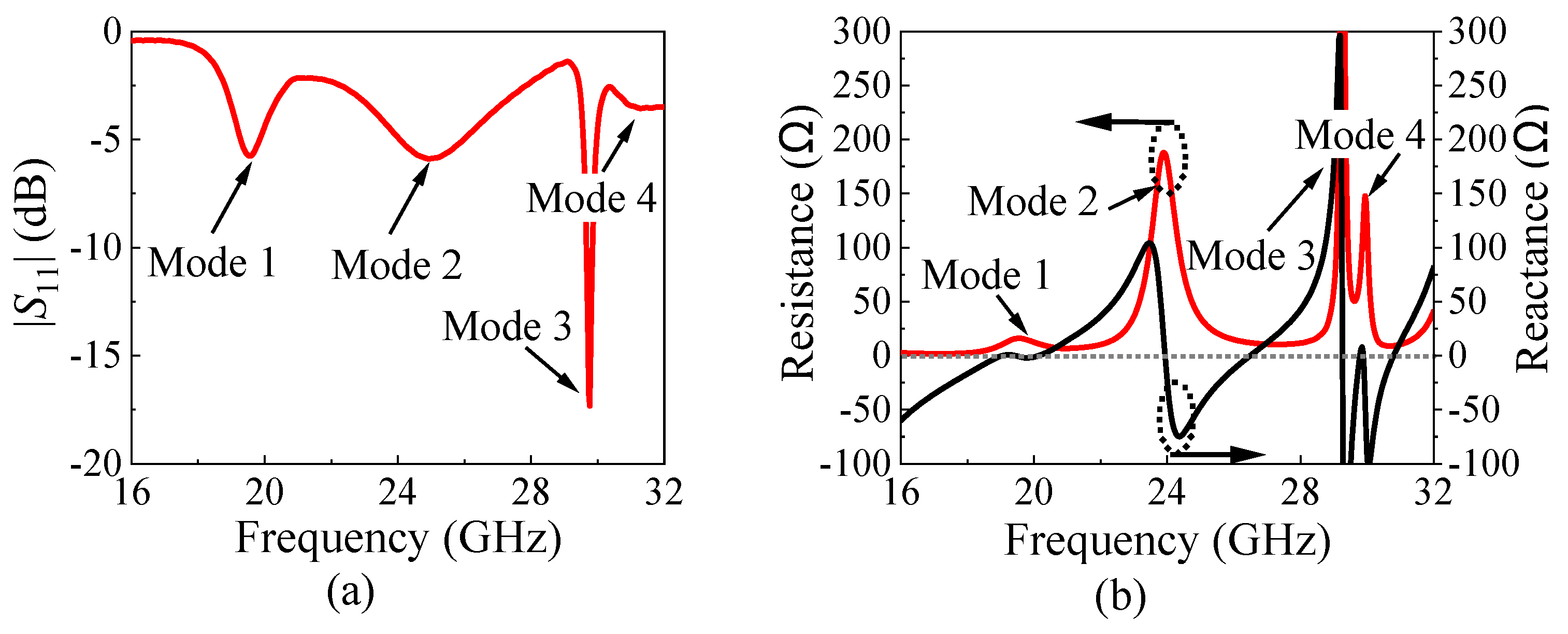



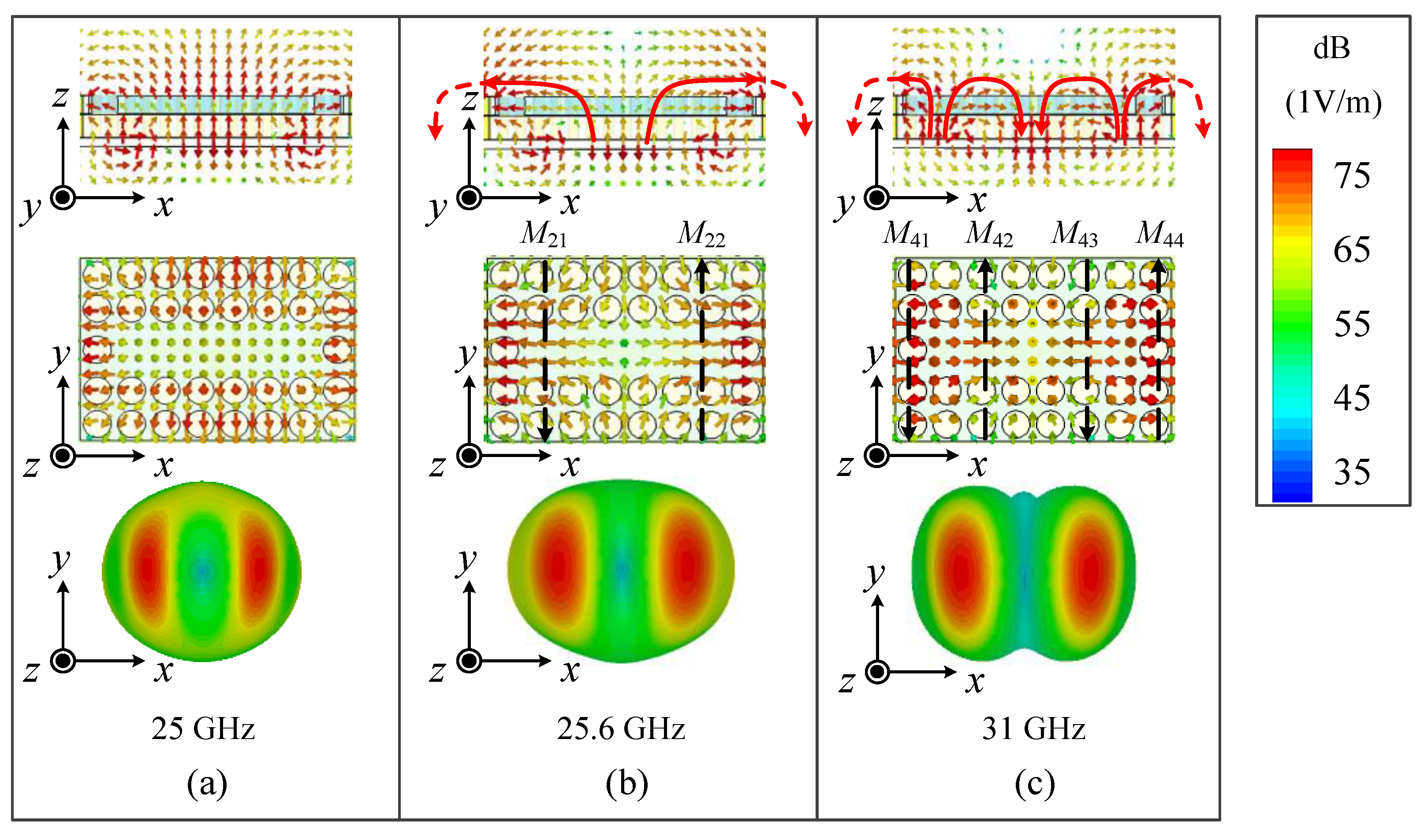

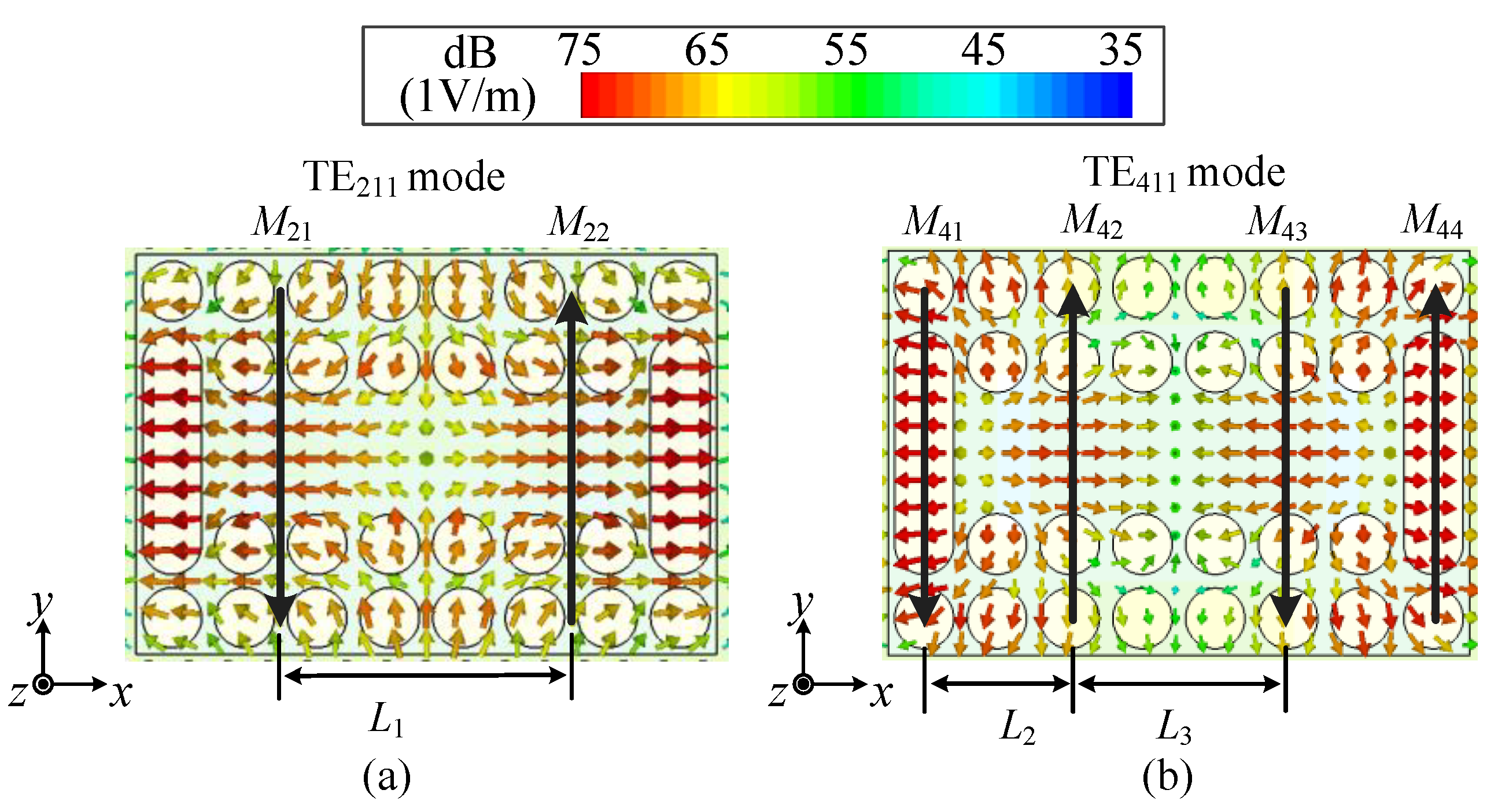

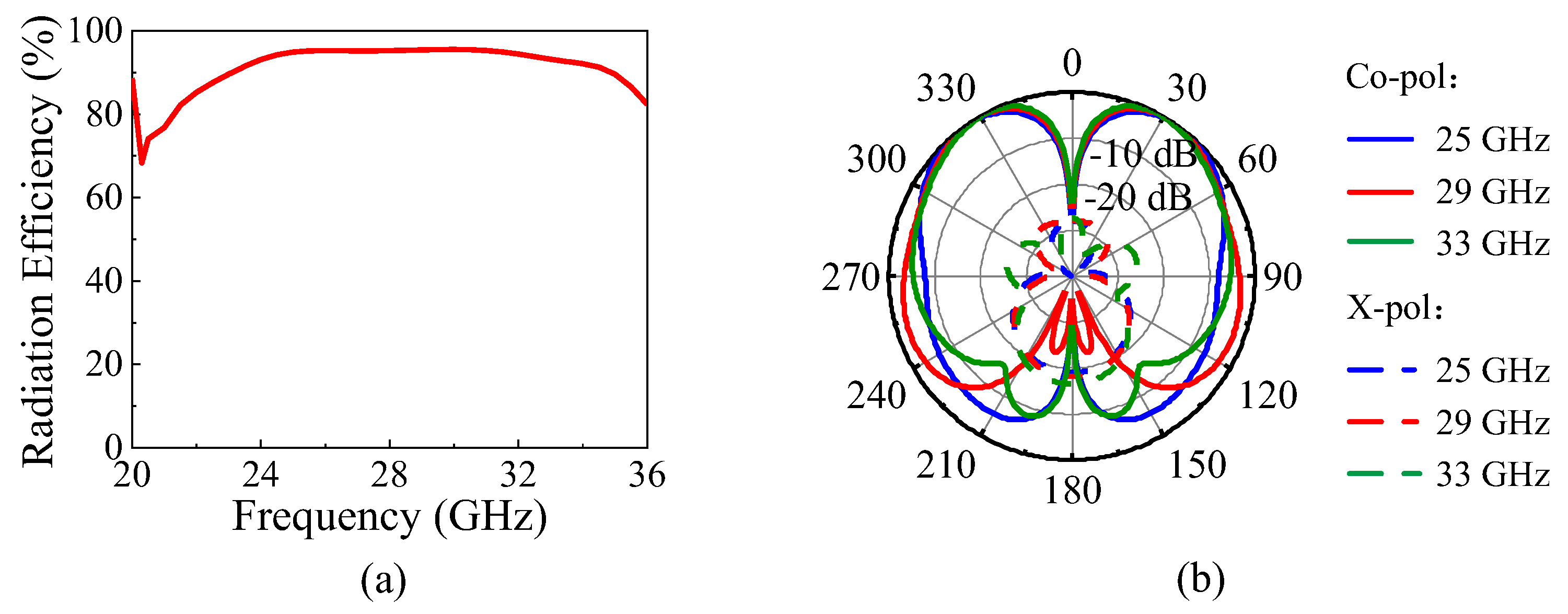

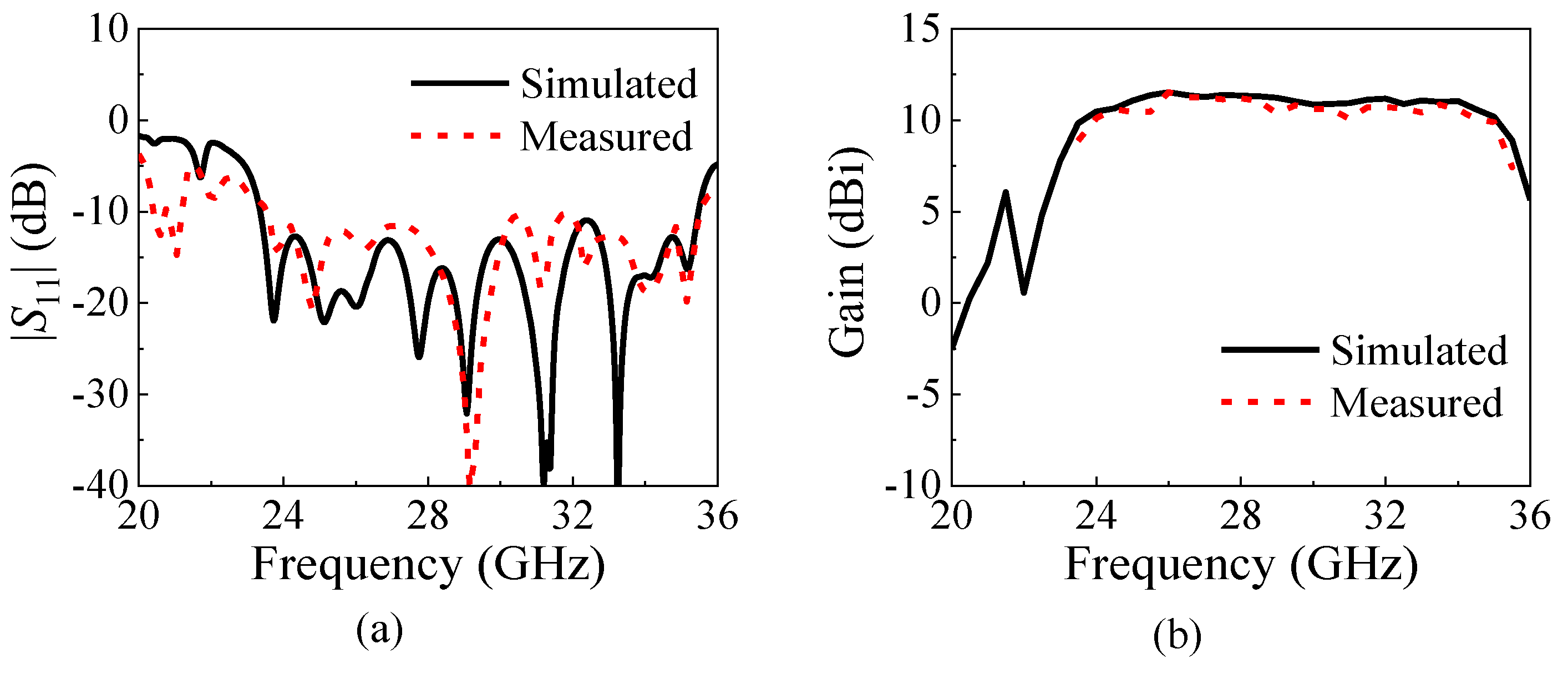
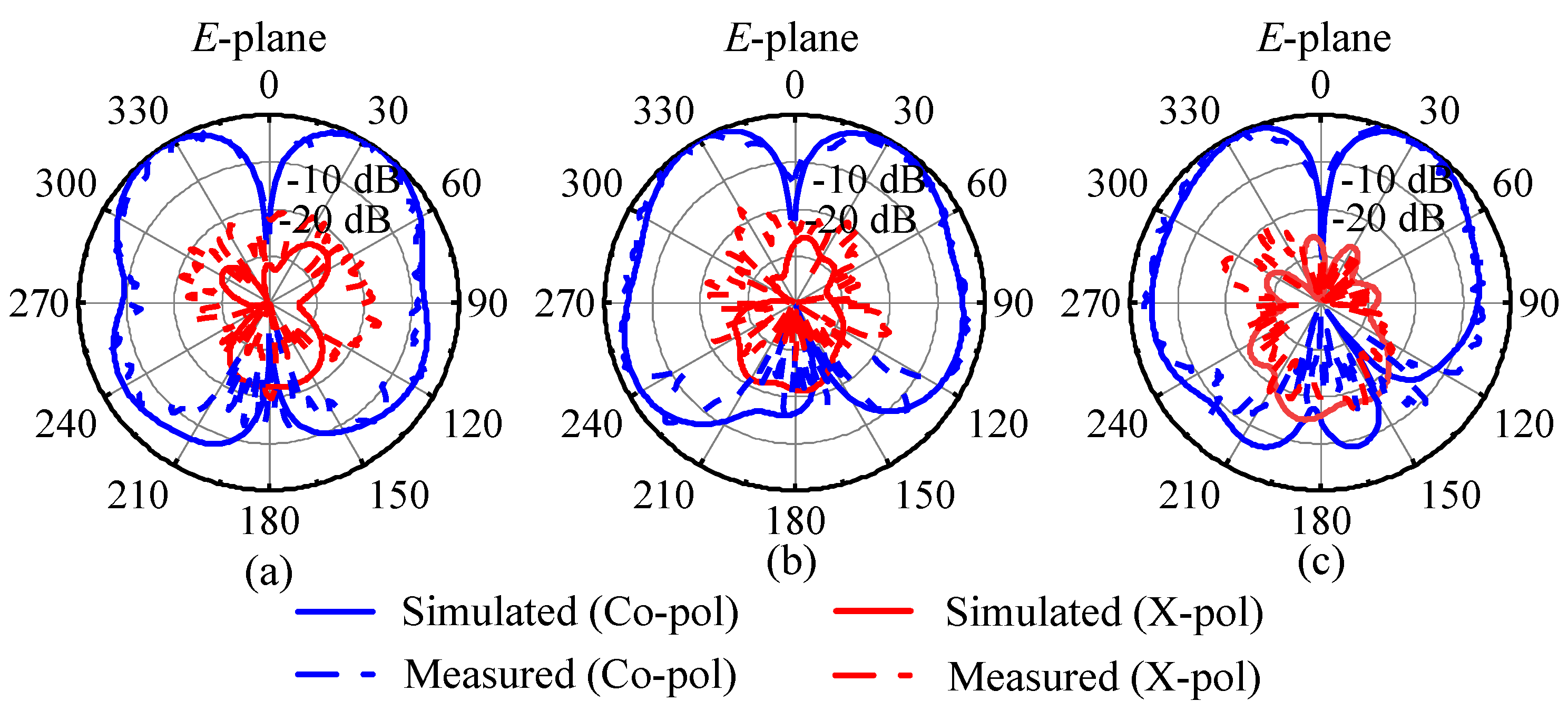
| Ref. | Antenna Type | f0 (GHz) | Sizes (λ0 × λ0) | 10 dB FBW 1 (%) | Radiation Pattern | Peak Radiation Efficiency (%) |
|---|---|---|---|---|---|---|
| [14] | Patch | 5.49 | 0.62 × 0.49 | 11.3 | Dual-beam | 95 (element) |
| [15] | Patch | 29.35 | 1.55 × 1.47 | 10.6 | Dual-beam | - |
| [16] | Patch | 5.38 | 0.81 × 0.72 | 19.3 | Dual-beam | ~87 (element) |
| [17] | Patch | 3.5 | 1 × 3.7 | 23.5 | Dual-beam | - |
| [18] | DRA | 6.4 | 0.77 × 0.77 | 4.7 | Dual-beam | - |
| [21] | SIDRA | 9.8 | 1.25 × 1.21 | 33.4 | Broadside | 92 (element) |
| [22] | SIDRA | 24 | 0.64 × 0.88 | 34 | Broadside | 93 (element) |
| This work | SIDRA element | 29 | 1.8 × 0.75 | 42.2 | Dual-beam | 95.5 |
| SIDRA array | 29.4 | 4.8 × 2.06 | 41.2 | Dual-beam | 83 |
Disclaimer/Publisher’s Note: The statements, opinions and data contained in all publications are solely those of the individual author(s) and contributor(s) and not of MDPI and/or the editor(s). MDPI and/or the editor(s) disclaim responsibility for any injury to people or property resulting from any ideas, methods, instructions or products referred to in the content. |
© 2024 by the authors. Licensee MDPI, Basel, Switzerland. This article is an open access article distributed under the terms and conditions of the Creative Commons Attribution (CC BY) license (https://creativecommons.org/licenses/by/4.0/).
Share and Cite
Shi, J.; Xu, R.; Wu, B.; Wang, L.; Jiang, R. A Wideband Millimeter-Wave Dual-Beam Dielectric Resonator Antenna with Substrate Integration Capability. Micromachines 2024, 15, 1022. https://doi.org/10.3390/mi15081022
Shi J, Xu R, Wu B, Wang L, Jiang R. A Wideband Millimeter-Wave Dual-Beam Dielectric Resonator Antenna with Substrate Integration Capability. Micromachines. 2024; 15(8):1022. https://doi.org/10.3390/mi15081022
Chicago/Turabian StyleShi, Jin, Ranhao Xu, Bowen Wu, Lei Wang, and Ruirui Jiang. 2024. "A Wideband Millimeter-Wave Dual-Beam Dielectric Resonator Antenna with Substrate Integration Capability" Micromachines 15, no. 8: 1022. https://doi.org/10.3390/mi15081022
APA StyleShi, J., Xu, R., Wu, B., Wang, L., & Jiang, R. (2024). A Wideband Millimeter-Wave Dual-Beam Dielectric Resonator Antenna with Substrate Integration Capability. Micromachines, 15(8), 1022. https://doi.org/10.3390/mi15081022





